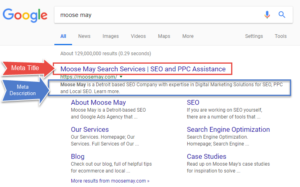SEO (Search Engine Optimization) is a multi-faceted industry, and SEO experts wear many different hats during a typical day. Just like learning a new language, to help you better understand and communicate more effectively with your SEO team, it helps to learn some basic terms. Today I am going to give you a quick overview of basic on-page definitions and concepts.
From meta titles and descriptions to H tags, we’ve got you covered in this quick overview of basic on-page definitions.
An Overview of Basic On-Page Content for SEO
Before we talk about definitions, you need to understand what on-page SEO is. On-page SEO is the practice of optimizing web pages to rank well in search engines. Meaning, on-page content is really the bread and butter of your website. The page content is your opportunity to connect with and craft answers to a searcher’s question.
Not only is on-page SEO multi-faceted, but it extends well beyond just content. Things like schema, image optimization, and alt text are some of the more advanced on-page concepts but we won’t get into that in this blog. (You can read a more in-depth guide to on-page SEO here.) In short, on-page refers to both the content and HTML source code of a webpage.
On-Page Text
This is referring to the actual written content of a web page. This is where you can make an impact on your visitors. Providing valuable information is not only great for visitors to understand what your brand or business is about, but search engines also use this content to help display your site in search results.
On-Page Keywords
This refers to the words in your on-page text that searchers are likely using to answer a question or fulfill a need. Integrating keywords into your on-page text helps your website rank better in search engine results pages (SERPs).
Meta Definitions
Metadata is also referred to as just meta which is a set of information that search engines use to determine what your web page is about. The most important metadata are titles and descriptions.

Meta Title
Sometimes referred to as title tags, the Meta Title is a descriptive HTML element that specifies what the webpage is about. It also serves as the “clickable” link in search results. It is important the Meta Title is written carefully with close attention to keywords, length, and most importantly, a clear description of the webpage.
Meta Description
This is the text that is right under the Meta Title in the SERPs. It further helps describe what the webpage is about.
Page Content Optimization
Structuring your on-page content is important because it provides a visual hierarchy that helps both readers and search engines understand it better.
Header Tags
Header tags are another HTML element that is used to designate headings on your page. The main header tag is called an H1 and is typically used as the title or “headline” of the page. It looks like this:
<h1>Page Title</h1>
There are also sub-headings that typically placed under the H1, kind of like an umbrella. These include H2 (<h2>) to H6 (<h6>) tags and are not always required. The hierarchy of header tags goes from H1 to H6, with the H1 being the most important and the H6 the least important content of the page.
While this list is not all-inclusive, we hope it helps provide some basic definitions of on-page SEO terms. Want to learn more about digital marketing and SEO? Subscribe to our blog to receive helpful tips like this one delivered straight to your inbox!